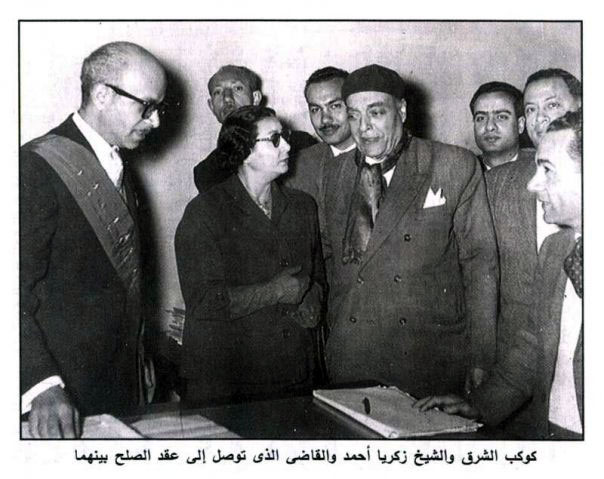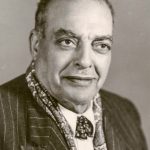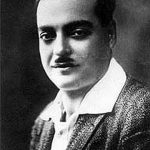Amar Foundation Presents: Min Al-tarikh
Mustafa Said: Welcome to a new episode of Min Al-Tarikh where, together with his highness Farid Abu-Shona pasha, known in the academic field as Professor Frederique Lagrange, we proceed with our speech about the very beautiful trio namely Bayram, Ziko and Thouma. We now leave aside the cinema and talk about three of the songs written by Bayram, composed by Zakariyya and sung by Om-Kolthoum.
Frederique Lagrange: Let’s start with Ahl El-Hawa. The exact date of Ahl El-Hawa is not known exactly, but, it’s probably in 1944. It’s strange though because if Om-Kolthoum had sung it for the first time in 1944, do you know when she sang it for the last time?

M: After a long time. I believe around the 1950’s or early 60’s.
F: by the end of the 1950’s. The last concert in which Ahl El-Hawa was presented was in 1959. We’ve 10 recordings of Ahl El-Hawa regardless of the lost performances. This means that this song remained with Om-Kolthoum for 15 years; something uncommon for Om-Kolthoum. You know that any song stays with Om-Kolthoum for two or three years then it was put on the shelf and finally forgotten. There’re exceptions to this as we’ve songs that remained with her for five or ten years, apparently, these were songs that she loved direly.
M: or loved by the audience or by both.
F: or by both. I do not know about the audience. But, Om-kolthoum didn’t pay much attention to the audience. I don’t mean it literally, but she was a strong and authoritative woman who could inflict her will on the audience and impose her really preferred songs. Amongst these songs she returned to, it’s known that in 1943 in the concert of the Lycée Français, she decided to sing something of Sheikh Aboul-Ila Mohammed.
M: 16 years after his death.
F: Yes, exactly. But this was a return after a long absence.
M: Also, the story of Ra’ El-Habeeb which she sang after a long time because El-Qassabgi asked her to sing it.
F: The last concert in which she sang Ra’ El-Habeeb was in 1956. With Ahl El-Hawa, however, Om-Kolthoum had been singing it between 1944-1959 almost every year. There was a recording for Ahl El-Hawa for each year though she and Zakariyya Ahmed were not in good terms for the well-known financial reasons. Let’s be frank, she was avaricious, and she was mean to him.
M: She herself confessed that much in a private session. When they asked her whether there were things that she had regretted. She answered that there’re many things. When they asked her “like what?”, she said “When I was mean to Sheikh Zakariyya Ahmed”.
F: It was good of her to confess her guilt.
M: Not guilty, only that she made Sheikh Zakariyya Ahmed angry with her.
F: A semi confession.
M: Yes.
F: even when she ceased to sing for Sheikh Zakariyya Ahmed,
M: [Interrupting], she stopped singing new songs by him.
F: She stopped asking for new songs from him, but, as for the old songs, she’s not returned to the old songs except for Ahl El-Hawa and Ana Fi Intizarak. There’re also several recordings for El-Amal after their discrepancy. Ahl El-Hawa is the song in which Om-Kolthoum turns to this legendary being I referred to before, and she had been singing it throughout the 1950’s even though she no longer sang for Sheikh Zakariyya, not for Bayram as she sang Shams El-Aseel, but she sang no more for Sheikh Zakariyya except for Ana Fi Intizarak, yet the last concert in which she sang it was in 1955. Ahl El-Hawa, however, continued till 1959. Unfortunately, she hasn’t returned or performed to the long theatrical songs composed for her by Zakariyya Ahmed earlier, hence the lost items of the partnership between Bayram, Zakariyya Ahmed and Om-Kolthoum were massive compared to the other losses. Ana Wenta doesn’t exist, Koll El-Ahibba Etneen Etneen doesn’t exist, also Ektibli Kteer and Eih Asammi El-Hobb…etc, a huge number of lost songs aren’t lost only as recordings by Om-Kolthoum, but also as compositions. There’s, for instance, the famous recording which is said to be by the daughter of Sheikh Zakariyya Ahmed. Let’s listen to an excerpt of it.
[Listen to an excerpt of Koll El-Ahibba Etneen Etneen by Sheikh Zakariyya’s daughter.].M: Let’s get back to Ahl El-Hawa and the absolute love, the collaboration of Bayram, Zakariyya and Om-Kolthoum.
F: I would like to approach from a different way: when literature speaks about literature, critics use the term Meta-textuality. Meta-textual is a description of a text when it deals with other texts or about the writing techniques. Why this approach? Ahl El-Hawa is a song about the Layali, a song that contains Layali. Not only this, but the main topic of the text is the Layali. Layali is a technique used in the traditional Arabic songs, i.e., the improvisation on “Ya Leel ya Ain” be it a rhythmic or rhythm-free improvisation. Why the use of “Ya leel ya Ain”? First, the vocal improvisation must use words or syllables. The vowels in these syllables could be open like long open A as in Aah. The improvisation on the word “Aah” is what we call “Aahat”. The Vowel may also be rounded O or closed U as in “oof, oof, oof” in the Levantine tradition, hence the improvisation is on the syllable “oof” which a singer produces when the mouth is rounded o closed. The Egyptian tradition is centred around the “E” and “I” sounds with the fricative consonants represented by the Arabic letters Lam, Nun and Ain. Unlike the plosive consonants as described by phonetics, these are continuous sounds in which the breath can extend. This is the explanation from a musical and phonetic prospective. From a linguistic or semantic prospective, the Ain which means [eye] may mean the eye of the beloved, and the Leel, which means [night] can be one of two things: it may refer to happiness when the lover and beloved are together, or to sedge, when the lover stays awake at night thinking about his beloved. Zakariyya Ahmed said “we say Ya leel ya Ain”, this chanting tradition addresses the night, and this night may either be a very long night in which we’re awake and time doesn’t pass, or a very short night in which times passes quickly as we’re with the beloved. He took this idea and Bayram developed it to convey both cases. Zakariyya, in turn, took the idea and said that as we will be talking about the Layali and you write an article about that in a poetic form about the “ya leel ya Ain” tradition in the Egyptian tradition, I’ll demonstrate musically both the happy nights and the sad nights, and I’ll leave a space for Om-Kolthoum to create her own improvisations in dealing with these Layali. No single performance exists for this stunning song without a surprising sentence improvised by Om-Kolthoum for these Layali, or in the overall performance of this text about the concept of Layali in the Egyptian chanting tradition. I don’t know whether my words are understandable or like talismans.
M: In all the existing recordings of Ahl El-Hawa, though I think that Om-Kolthoum always leans towards the fixed sentences, in this song, as well as in the upcoming song El-Awwila fel-Gharam, each recorded version of this tune has its special characteristics and its unique improvisation so much so that we may sometimes say that there are two versions which are hardly related to each other.
F: I would like to focus on two concerts of Ahl El-Hawa: First, the version of the concert in Ramadan 1952. Why Ramadan 1952? We know that this was the third interval which in the very late night in Ramadan. People want to leave back home for Sahur before the beginning of the fasting time. Om-Kolthoum sang Ahl El-Hawa almost in 25 minutes. She could sing it in a full hour as in the second concert about which we’ll talk later. The 1952 concert is a brief demonstration of Om-Kolthoum’s geniality in improvisation with numerous, recurring and intense improvisations despite the shortness of the recording. The 1952 version is dazzling, it contains two extracts the first of which is a refusal of a suggestion by Mohammed Abdu Salih with a more beautiful response to this suggestion than what he may have imagined. In the middle of her improvisation on the lyrics “Ahl El-hawa ya leel, fatu madagi’hum, wetgamm’u ya leel, sohba wana me’hum”, Mohammed Abdu Salih suggested that she modulates to Maqam Saba, an idea that could have been very gorgeous as there’s no recording for Ahl El-Hawa in which Om-Kolthoum modulated to Saba. Of course she heard this suggestion, but, she rejected it, and instead she sang in Nahawand or Ushshaq, then continued and descended to Nahawand, and then she repeated the sentence in Rast.
M: [interrupting], yes, Rast to continue to the next part.
F: yes, exactly.
M: I think she was aware of the time element.
F: Probably, yet the idea that he wanted her to go a certain way and her response to him without any verbal communication: “no man, I’ll take this way, but still, I’ll surprise you”, because the idea of being in Ushshaq was surprising as she used to sing it either in Bayyati or in Rast. Staying in Ushshaq and then repeating it in Rast was really genial, a real hit.
[Listen to the above-mentioned extract.].F: The other extract I mean is by the end of the song when she enters the Mawlid atmosphere. In most of her rhythmic improvisations, Om-Kolthoum used to improvise on Wahda rhythm, however, here she improvised on Maqsoum. I always feel that improvising on Maqsoum gives the listener the impression that he’s in a Mawlid, especially when all the musicians, actually not all the musicians, better, let’s say the Takht within the ensemble as in Om-Kolthoum’s big ensemble there’s a traditional Takht, when this hidden Takht appears and returns to the beauties of the Takht, it also enters the Mawlid atmosphere. See how music can be developed from within. The idea of turning a musically classical song into a Mawlid was not common in the early 20th century, a folkloric reference in order to make it very danceable in a very charming and genial manner.
M: This takes us back to the atmosphere of the Mawlid chanters amongst whom Om-Kolthoum was brought up.
F: Exactly.
M: Remember that 1952 was the peak of the disagreement between Om-Kolthoum and Sheikh Zakariyya.
F: You’re right. She may have created this Mawlid part to tease him.
M: I do not think so because, if we listen to Sheikh Zakariyya’s recording of Ahl El-Hawa which he made for the radio, he made the same Mawlid in the same place, and additionally, he kept the rhythm on while he sang from the high notes because he had a chorus. Om-Kolthoum never had a chorus with her on stage. Sheikh Zakariyya used a chorus, so when he reached this part,
[Listen to the Mawlid from Sheikh Zakariyya’s recording.]M: this reminds us not of the folkloric chanters, yet, of the chanting of the Laythi order when people remain in the bass repeating “La Ilaha Illa Allah” while one or more of the chanters sing the poetry, they usually chant.
[Listen to another excerpt of the same place from Sheikh Zakariyya’s recording.].F: It seems that in this part, Om-Kolthoum could simultaneously play the role of the Chanter and the chorus, everything together. Let’s listen to this part from her:
[Listen to the same part from Om-Kolthoum’s 1952 version.]F: Another point: I don’t know exactly when the Çefte Telli tradition started in the Egyptian music. The idea that as the Çefte Telli rhythm starts, it prepares the mind of the listener to an improvisation. Çefte Telli didn’t exist in the 1910’s and 1920’s recordings. The first time I noticed that it’s linked with improvisation was in the songs of Mohammed Abdel-Wahhab’s movies. This was the beginning. Afterwards was Farid Al-Atrash. This is something we also find with Zakariyya Ahmed in “Nas min Olobha t’ool ya leel”. I think this one of the very rare examples of improvising on Çefte Telli by Om-Kolthoum. What I want to stress here is that whenever the Egyptian or Arabic listener hears the Çefte Telli, it immediately means improvisation is on the way. We find this with Om-Kolthoum almost only in the compositions of Sheikh Zakariyya Ahmed. I do not know whether he was one of the generations who set this new concept in the Egyptian tradition or was he who set this concept and fixed it in the Egyptian tradition.
M: In my opinion both Bamb and Çefte Telli are one and the same rhythm, probably with minor differences, yet the Çefte Telli is a slightly slower Bamb.
F: They are probably the same rhythm, yet the Bamb used to be at the end.
M: Yet, we do not know how it was in the life performances, before or after the Dawr, we do not know how it was in the life performances. Çefte Telli, however, may have resulted from the fashion of slowing down everything. Probably we heard the Bamb in the records because it was the faster rhythm. We don’t know. In my opinion, the improvisation on Çefte Telli was a development of the improvisation on Wahda.
F: Extension of the Layali on the Bamb which were at the end of the early records, I agree with you.
M: or the start of the records.
F: But, here the Layali on Bamb was inserted in the middle of the song in a slower tempo as you said.
M: but the concept of the Wasla was being reinvented here. Here, the song is the Wasla. There’s no Peşrev, Muwashshah or Mawwal. The concept was reinvented so that the song itself became the whole Wasla, so, it had to contain all the elements of a Wasla.
F: OK.
M: let’s not forget also that the Çefte Telli was generally used in the instrumental improvisation and then turned into vocal. It may have also come from the folkloric music. God only knows. Let’s terminate this episode with the recording that took place by the beginning of Ramadan and by the end of May of 1952. You mentioned Mohammed Abdu Salih in a very worthy reference, yet I’d like to refer also to Ibrahim Afeefi. Look how he was a rival of Om-Kolthoum as if singing with her using Riqq. Rhythm is very important, not only a tempo keeper. Ibrahim Afeefi was part of the movement of the very work. Now, we reach the end of this episode. Until we meet in a new episode in which we resume our discussion of Ahl El-Hawa, we leave you with Bayram, Zakariyya and Om-Kolthoum.
[Listen to the full recording of Ahl El-Hawa, the 1952 version of Om-Kolthoum].The end.
- 221 – Zakariyya Ahmed – 12 (1/9/2022)
- 220 – Zakariyya Ahmed – 11 (1/9/2022)
- 219 – Zakariyya Ahmed – 10 (11/25/2021)
- 218 – Zakariyya Ahmed – 9 (10/26/2021)
- 217 – Zakariyya Ahmed – 8 (9/24/2021)
- 216 – Zakariyya Ahmed – 7 (9/4/2021)
- 215 – Zakariyya Ahmed – 6 (8/28/2021)
- 214 – Zakariyya Ahmed – 5 (8/6/2021)
- 213 – Zakariyya Ahmed – 4 (6/26/2021)
- 212 – Zakariyya Ahmed – 3 (5/27/2021)
- 211 – Zakariyya Ahmed – 2 (5/1/2021)
- 210 – Zakariyya Ahmed – 1 (4/28/2021)
- 209 – W-al-Lāhi lā astaṭī‘u ṣaddak 2 (4/6/2017)
- 208 – W-al-Lāhi lā astaṭī‘u ṣaddak 1 (3/30/2017)
- 207 – Bashraf qarah baṭāq 7 (3/23/2017)


